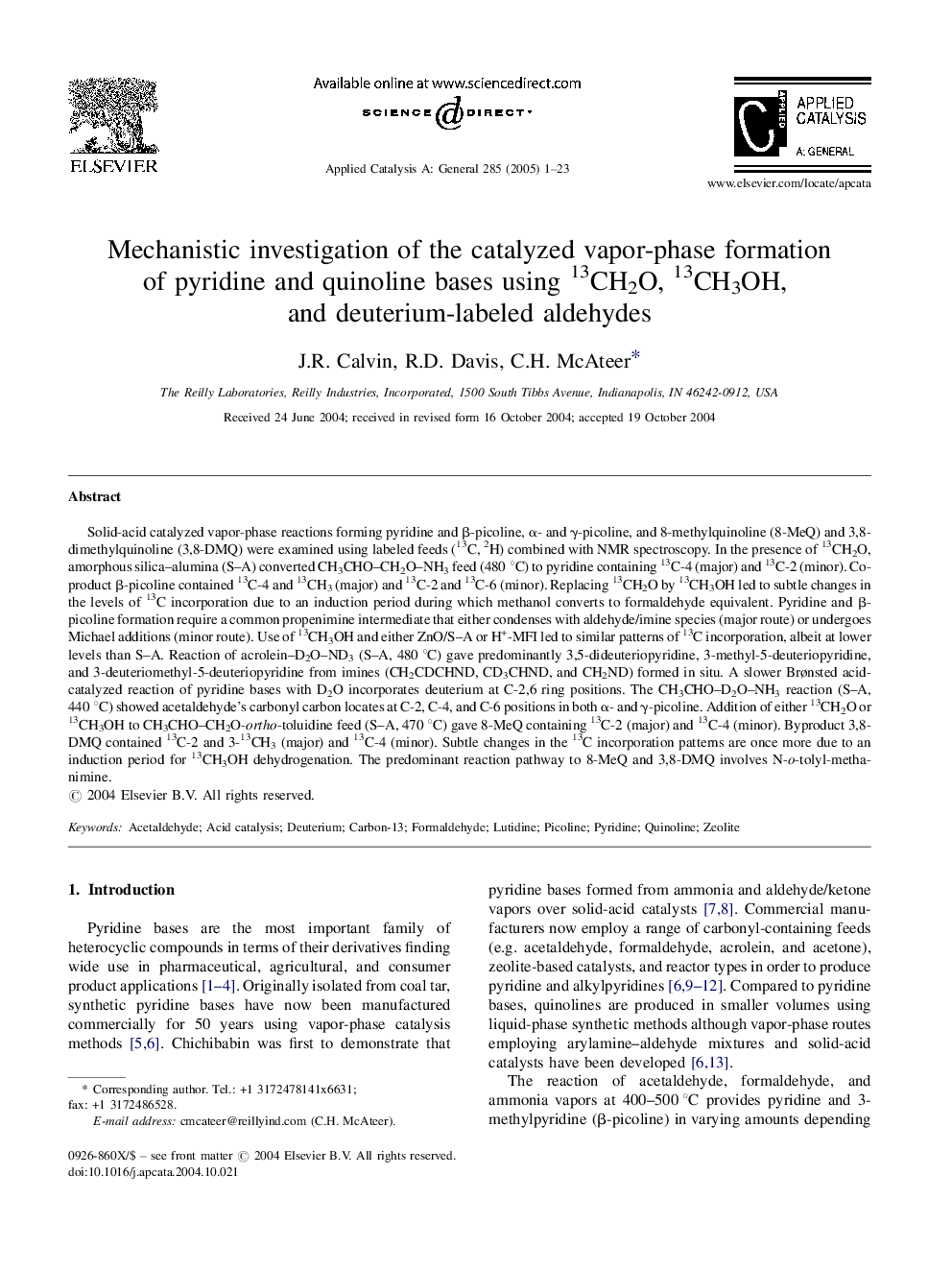| کد مقاله | کد نشریه | سال انتشار | مقاله انگلیسی | نسخه تمام متن |
|---|---|---|---|---|
| 9607941 | 46058 | 2005 | 23 صفحه PDF | دانلود رایگان |
عنوان انگلیسی مقاله ISI
Mechanistic investigation of the catalyzed vapor-phase formation of pyridine and quinoline bases using 13CH2O, 13CH3OH, and deuterium-labeled aldehydes
دانلود مقاله + سفارش ترجمه
دانلود مقاله ISI انگلیسی
رایگان برای ایرانیان
کلمات کلیدی
موضوعات مرتبط
مهندسی و علوم پایه
مهندسی شیمی
کاتالیزور
پیش نمایش صفحه اول مقاله

چکیده انگلیسی
Solid-acid catalyzed vapor-phase reactions forming pyridine and β-picoline, α- and γ-picoline, and 8-methylquinoline (8-MeQ) and 3,8-dimethylquinoline (3,8-DMQ) were examined using labeled feeds (13C, 2H) combined with NMR spectroscopy. In the presence of 13CH2O, amorphous silica-alumina (S-A) converted CH3CHO-CH2O-NH3 feed (480 °C) to pyridine containing 13C-4 (major) and 13C-2 (minor). Co-product β-picoline contained 13C-4 and 13CH3 (major) and 13C-2 and 13C-6 (minor). Replacing 13CH2O by 13CH3OH led to subtle changes in the levels of 13C incorporation due to an induction period during which methanol converts to formaldehyde equivalent. Pyridine and β-picoline formation require a common propenimine intermediate that either condenses with aldehyde/imine species (major route) or undergoes Michael additions (minor route). Use of 13CH3OH and either ZnO/S-A or H+-MFI led to similar patterns of 13C incorporation, albeit at lower levels than S-A. Reaction of acrolein-D2O-ND3 (S-A, 480 °C) gave predominantly 3,5-dideuteriopyridine, 3-methyl-5-deuteriopyridine, and 3-deuteriomethyl-5-deuteriopyridine from imines (CH2CDCHND, CD3CHND, and CH2ND) formed in situ. A slower Brønsted acid-catalyzed reaction of pyridine bases with D2O incorporates deuterium at C-2,6 ring positions. The CH3CHO-D2O-NH3 reaction (S-A, 440 °C) showed acetaldehyde's carbonyl carbon locates at C-2, C-4, and C-6 positions in both α- and γ-picoline. Addition of either 13CH2O or 13CH3OH to CH3CHOCH2O-ortho-toluidine feed (S-A, 470 °C) gave 8-MeQ containing 13C-2 (major) and 13C-4 (minor). Byproduct 3,8-DMQ contained 13C-2 and 3-13CH3 (major) and 13C-4 (minor). Subtle changes in the 13C incorporation patterns are once more due to an induction period for 13CH3OH dehydrogenation. The predominant reaction pathway to 8-MeQ and 3,8-DMQ involves N-o-tolyl-methanimine.
ناشر
Database: Elsevier - ScienceDirect (ساینس دایرکت)
Journal: Applied Catalysis A: General - Volume 285, Issues 1â2, 10 May 2005, Pages 1-23
Journal: Applied Catalysis A: General - Volume 285, Issues 1â2, 10 May 2005, Pages 1-23
نویسندگان
J.R. Calvin, R.D. Davis, C.H. McAteer,